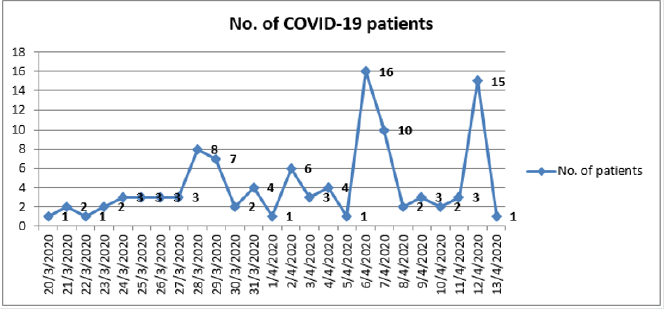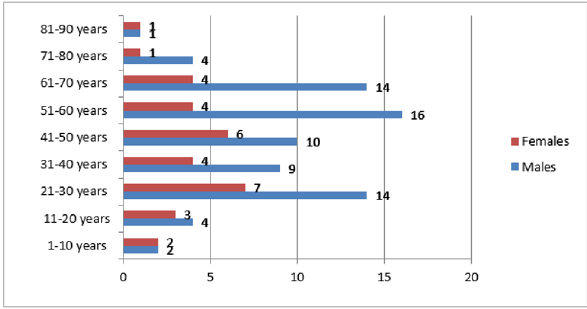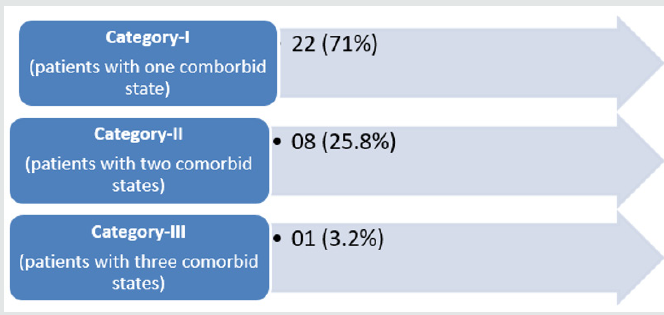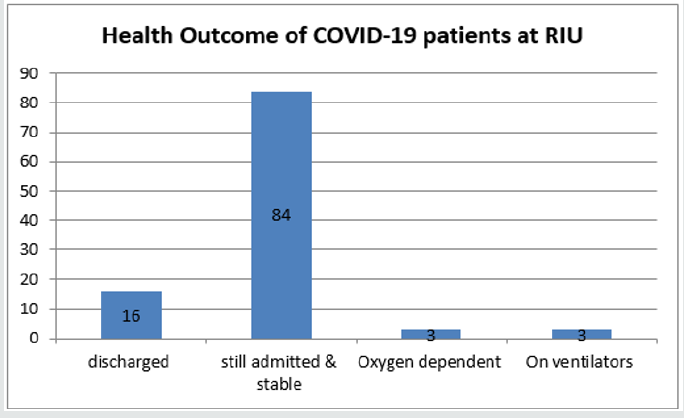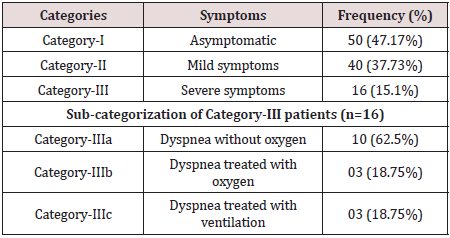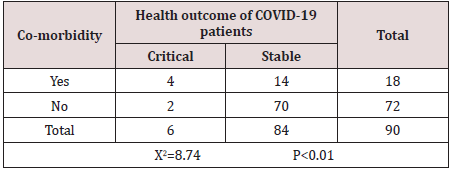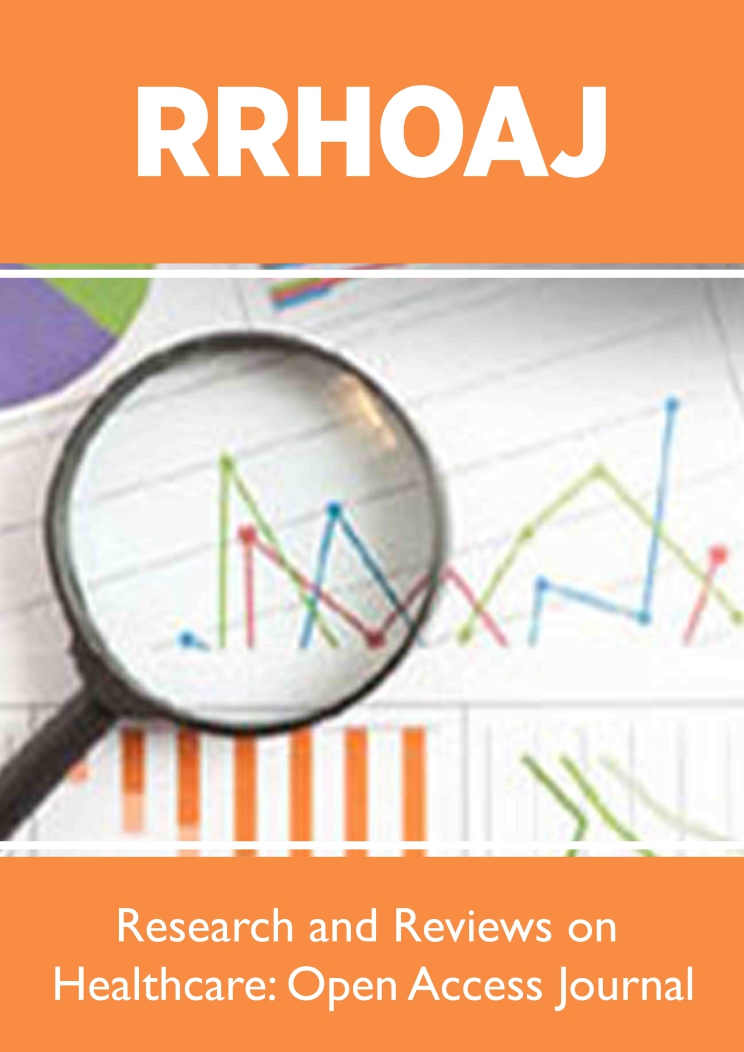
Lupine Publishers Group
Lupine Publishers
Menu
ISSN: 2637-6679
Research Article(ISSN: 2637-6679) 
An Overview of Preliminary COVID-19 Cases Admitted in Rawalpindi Institute of Urology & Transplantation Pakistan Volume 5 - Issue 2
Shazia Zeb*, Muhammad Umar, Rizwana Shahid, Qaiser Aziz, Muhammad Omar Akram, Muhammad Khurram, Khalid Randhawa and Muhammad Ahmed
- Department of Medical Education, Rawalpindi Medical University, Pakistan
Received: May 08, 2020; Published: May 21, 2020
Corresponding author: Shazia Zeb, Department of Medical Education, Rawalpindi Medical University, Pakistan
DOI: 10.32474/RRHOAJ.2020.05.000210
Abstract
Objectives: To determine the source of infection, comorbidity and health outcome of COVID-19 patients admitted in Rawalpindi Institute of Urology & Transplantation (RIU & T) Pakistan.
Methods: A cross sectional descriptive study was carried out among 106 Polymerase Chain Reaction (PCR) confirmed COVID-19 cases admitted at Rawalpindi Institute of Urology & Transplantation from 20th March-13th April 2020. These patients were enrolled in research through consecutive sampling. The data was gathered pertinent to demographics, symptoms, source of infection, comorbidity and health outcome of the COVID-19 patients. The data was analyzed by means of SPSS version 25.0.
Results: Of the total 106 COVID-19 cases, 74(69.8%) were males and 32(30.2%) were females. Mean age of COVID-19 patients was 45.24±18.63 years. About 73(69%) had contact history with their close family members while 31(29.2%) had travel history. About 35(33.02%) had persistent dry cough, 31(29.24%) had high grade fever 16(15.1%) had shortness of breath and 21(19.8%) complained of sore throat. Time period between positive PCR diagnostic report and negative PCR report was determined to be 11.5±1.32 days. Most 22(71%) had one comorbidity and hypertension was most prevalent among our patients followed by diabetes, renal, hepatic and cardiovascular diseases. Comorbidity showed statistically significant association (P<0.01) with critical illness among COVID-19 patients. Hydroxychloroquine and Azithromycin were given to all the patients.
Conclusion: Most of the COVID-19 patients were infected by close contacts who returned from abroad. All COVID-19 patients were alive. Older hypertensive males being more at risk of coronavirus infection should strictly seek precautionary measures.
Keywords: COVID-19; Source of Infection; Comorbidity; Polymerase Chain Reaction; Hypertension
Introduction
Corona virus disease is an infectious disease that is attributed to
SARS-CoV-2 which belongs to corona virus family. This disease was
declared as global health emergency by World Health Organization
on 30th January 2020 following confrontation of unprecedented
challenges by the population of China [1]. This disease is directly
transmitted through droplets and contact with infected persons
while touching contaminated fomites facilitates its indirect spread
[2]. COVID-19 cases are either found to be symptomatic or suffering
from mild clinical symptoms [3]. However, some of them present
with acute lung injury and Acute Respiratory Distress Syndrome
(ARDS) that ultimately leads to respiratory failure and expiry
[4]. Elderly population and individuals with co-morbidities like
cardiovascular disorders and diabetes are highly vulnerable to
corona virus disease with grave consequences [5]. People with
clinical as well as sub-clinical corona virus infections are amenable
to transmit disease to others, so the suspects should primarily be
screened followed by hospitalization on disease confirmation [6].
COVID-19 sprouted from Wuhan (China), depicted exponential
growth and crossed borders with marked emergence of cases in
numerous countries [7]. COVID-19 pandemic appeared in Pakistan
during February 2020 that was attributed to returners from Iran
[8]. Till then emergence of SAR CoV-2 massively worldwide has compelled everybody to think about its spread in mass gatherings.
This perspective enabled administrative and managerial authorities
of most of the countries to declare cessation and cancellation of all
national and international religious congregations, sporting and
matrimonial events to limit the blowout of COVID-19 [9].
Since detection of first COVID-19 case in Pakistan, diverse arms
of federal, provincial and district governments have joined together
to mitigate the disastrous effects of COVID-19 through lockdown
for social distancing in addition to application of isolation of superspreaders
and keeping suspects in quarantine [10] because of nonavailability
of vaccine against SAR CoV-2 and lack of efficacious
drugs [11]. Our health professionals being frontline fighters are
also leading the battle against COVID-19 courageously despite of
scarce resources [12]. Rooting out the clinical presentations in
association with co-morbidities and transmissibility of corona virus
infection among affected population will be very informative to
cope up with this havoc timely and efficiently. The present research
is therefore carried out to appraise the severity and health outcome
of confirmed COVID-19 cases admitted in Rawalpindi Institute
of Urology & Transplantation (RIU & T) in connotation with
comorbidities and infective sources so as to ensure the placement
of appropriate preventive and managerial measures to minimize
the rapid spread of this contagious disease.
Subjects & Methods
A cross-sectional descriptive research was carried out among primary COVID-19 cases admitted in Rawalpindi Institute of Urology & Transplantation from 20th March-13th April 2020. Total 106 cases were enrolled in this study through consecutive sampling. The data was gathered pertinent to their demographics, travel and contact history, clinical presentations and comorbidity after getting informed consent from hospital administration. The data was analyzed by using SPSS version 25.0.
Results
Of the total 106 COVID-19 cases admitted in Rawalpindi Institute of Urology and Transplantation, 74(69.8%) were males and 32(30.2%) were females. Mean age of COVID-19 patients was 45.24±18.63 years. Trend of COVID-19 cases from 20th March-13th April 2020 is shown in Figure 1. Majority of the infected males were in 51-60 years age group while most of the females were 21-30 years of age as depicted below in Figure 2. All COVID-19 cases with positive PCR report were admitted in RIU & T with immediate effect. Of the total 106 cases, 73(69%) had contact history with their close family relatives who recently returned from other country or city and was confirmed COVID-19 cases. About 29(27.3%) patients travelled internationally, 2(1.9%) travelled nationally while 2(1.9%) had history of participation in religious congregations. Approximately 99.6% patients were residents of District Rawalpindi with highest frequency of patients residing in Gujar Khan as shown below in Table 1.
About 31(29.24%) out of 106 had comorbid states that included diabetes, hypertension, Ischemic Heart Disease, renal problems, asthma and hepatitis C. Comorbidity of COVID-19 cases is categorized as follows Figure 3. Of the total 106 patients enrolled in this study, 35(33.02%) had persistent dry cough, 16(15.1%) had shortness of breath, 21(19.8%) had sore throat and 17(16.04%) complained of general weakness. About 31(29.24%) had high grade fever and mean duration of fever was 5.03±3.2 days. Hydroxychloroquine and Azithromycin were given to all the patients. Approximately 50 patients were asymptomatic despite of positive PCR report as given below in Table 2. The duration between positive PCR diagnostic report and negative PCR report was determined to be 11.5±1.32 days. Health outcome of our patients is depicted below in Figure 4. Health outcome of COVID-19 patients seemed to have significant association (P<0.01) with their co-morbidity as depicted below in Table 3.
Discussion
COVID-19 pandemic has drastically affected the nations all over the world [13]. Coronavirus is known to enter the human body through respiratory tract or conjunctiva [14]. Because of varied differential diagnosis and contagiousness of disease, determining travel history and contact tracing of suspects is of paramount significance for real representation of this problem [15]. In current study, majority (19.8%) COVID-19 cases were in 21-30 years age group with males constituting highest frequency among them. Like our research, mainstream of South Korean population suffered from COVID-19 was comprised of 20-29 years age group with males constituting highest proportion of cases [16]. Contrary to this a research on Indian people revealed highest propensity of COVID-19 cases in 31-40 years age group [17]. On reviewing the COVID-19 cases reported from New York City of America, it became evident that males above 75 years old were more susceptible to coronavirus infection [18].
Likewise, our results, international research are also revealing more susceptibility of males towards COVID-19 as compared to females. Researchers have observed sex differences in every tissue and organ system of human body pertinent to coronavirus infection [19]. More infection vulnerability of males as compared to females might be due to more outdoor chores of males. However, this gender discrimination with respect to coronavirus infection is still under discussion and many trials are still to be undertaken to reach the conclusion.
In current study, the duration between onset of symptoms and diagnosis of coronavirus infection ranged from 0-19 days with median of 5 days. Most patients (33%) had persistent dry cough and 29.2% had fever on disease onset. Other symptoms were sore throat (19.8%), general weakness (16%) followed by shortness of breath (15.1%). Similarly, a Chinese research revealed time of up to 23 days (median=6 days) between appearance of symptoms and confirmation of coronavirus infection. About 65.8% patients had fever and 48.1% patients had cough followed by sore throat, headache, chills and diarrhea [20]. Another research by [21] revealed that fever, cough and myalgia are the commonest symptoms followed by abdominal pain, nausea and diarrhea [21]. This similarity in configuration of symptoms worldwide can be of great help in early detection and prompt treatment of cases.
The present study revealed statistically significant association (P<0.01) of comorbidity with critical state of COVID-19 patients although none of the enrolled patients succumbed to death. The comorbidity prevailing among our patients was predominantly hypertension followed by diabetes asthma and cardiovascular disorders. Like our study, a research on COVID-19 patients at China depicted hypertension as the commonest comorbidity followed by diabetes [22]. A similar research on COVID-19 New York citizens represented hypertension as the most frequent comorbidity followed by obesity and diabetes [23]. However, like current study results, other comorbidities in COVID-19 patients of China and New York City were renal, hepatic, cardiovascular and respiratory disorders. Moreover, aged male population specifically suffering from hypertension should adopt preventive measures more stringently as they are found to be more vulnerable to coronavirus infection.
Conclusion
COVID-19 cases in Pakistan predominantly attribute to contact with infected people. So preventive measures against corona virus infection should rigorously be adopted by our population to get rid of this havoc. Older males mainly suffering from hypertension should specifically be protected in this context.
Conflict of Interest
None.
References
- Zhou P, Yang XL, Wang XG, Hu B, Zhang L, et al. (2020) A pneumonia outbreak associated with a new coronavirus of probable bat origin. Nature 579(7798): 270-273.
- Chen H, Guo J, Wang C, Luo F, Yu X, et al. (2020) Clinical characteristics and intrauterine vertical transmission potential of COVID-19 infection in nine pregnant women: A retrospective review of medical records. Lancet 395(10226): 809-815.
- Yang X, Yu Y, Xu J, Shu H, Xia J, et al. (2020) Clinical course, and outcomes of critically ill patients with SARS-CoV-2 pneumonia in Wuhan, China: A single-centered, retrospective, observational study. Lancet Respir. Med 8(5): 475-481.
- Shereen MA, Khan S, Kazmi A, Bashir N, Siddique R (2020) COVID-19 infection: Origin, transmission, and characteristics of human coronaviruses. Journal of Advanced Research24: 91-98.
- Shim E, Tariq A, Choi W, Lee Y, Chowell G (2020) Transmission potential and severity of COVID-19 in South Korea. International Journal of Infectious Diseases93: 339-344.
- Rothe C, Schunk M, Sothmann P, Bretzel G, Froeschl G, et al. (2020) Transmission of 2019-nCoV Infection from an asymptomatic contact in Germany. N Engl J Med382(10): 970–971.
- Mizumoto K, Chowell G (2020) Transmission potential of the novel coronavirus (COVID- 19) onboard the diamond Princess Cruises Ship, 2020. Infectious Disease Modelling5: 264-270.
- Five suspected cases of coronavirus reported in Pakistan.Deccan Herald. 9 February 2020. Retrieved 4 March 2020.
- McCloskey B, Zumla A, Ippolito G, Blumberg L, Arbon P, et al. (2020) Mass gathering events and reducing further global spread of COVID-19: A political and public health dilemma. The Lancet 395(10230): 1096-1099.
- Pakistan’s evolving response to COVID-19.
- M Cattani (2020) Global coalition to accelerate COVID-19 clinical research in resourcelimited settings. The Lancet 395(10233): 1322-1325.
- Pakistan’ young doctors lead COVID-19 battle. The Nation.
- Coronavirus Disease 2019.
- Munster VJ, Koopmans M, Doremalen NV, Riel DV, Wit ED (2020) A novel coronavirus emerging in China-Key Questions for Impact Assessment. N Engl J Med 382(8): 692-694.
- Wu YC, Chen C, Chen Y (2020) The outbreak of COVID-19: An Overview. J Chin Med Assoc 83(3): 217-220.
- Shim E, Tariq A, Choi W, Lee Y, Chowell G (2020) Transmission potential and severity of COVID-19 in South Korea. International Journal of Infectious Diseases93: 339-344.
- Number of the coronavirus (COVID-19) cases in India 2020, by age group.
- Age, Sex, Existing conditions of COVID-19 cases and deaths.
- Does COVID-19 hit women and men differently? U.S is not keeping track. The New York Times.
- Han Y, Liu Y, Zhou L, Chen E, Liu P, et al. (2020) Epidemiological Assessment of imported coronavirus diseases 2019 (COVID-19) cases in the most affected city outside of Hubei Province, Wenzhou, China. JAMA Network Open3(4):e206785.
- Rahman S, Bahar T (2020) COVID-19: The New Threat. International Journal of Infection 7(1): e102184.
- Guan W, Liang W, Zhao W, Liang H, Chen Z, et al. (2020) Comorbidity and its impact on 1590 patients with COVID-19 in China: A nationwide Analysis. Eur Respir J.
- Richardson S, Hirsch JS, Narasimhan M, Crawford JM, McGinn T, et al. (2020) Presenting characteristics, comorbidities, and outcomes among 5700 patients hospitalized with COVID-19 in the New York City Area. JAMA 2020: E1-E8.

Top Editors
-

Mark E Smith
Bio chemistry
University of Texas Medical Branch, USA -

Lawrence A Presley
Department of Criminal Justice
Liberty University, USA -

Thomas W Miller
Department of Psychiatry
University of Kentucky, USA -

Gjumrakch Aliev
Department of Medicine
Gally International Biomedical Research & Consulting LLC, USA -

Christopher Bryant
Department of Urbanisation and Agricultural
Montreal university, USA -

Robert William Frare
Oral & Maxillofacial Pathology
New York University, USA -

Rudolph Modesto Navari
Gastroenterology and Hepatology
University of Alabama, UK -

Andrew Hague
Department of Medicine
Universities of Bradford, UK -

George Gregory Buttigieg
Maltese College of Obstetrics and Gynaecology, Europe -

Chen-Hsiung Yeh
Oncology
Circulogene Theranostics, England -
.png)
Emilio Bucio-Carrillo
Radiation Chemistry
National University of Mexico, USA -
.jpg)
Casey J Grenier
Analytical Chemistry
Wentworth Institute of Technology, USA -
Hany Atalah
Minimally Invasive Surgery
Mercer University school of Medicine, USA -

Abu-Hussein Muhamad
Pediatric Dentistry
University of Athens , Greece

The annual scholar awards from Lupine Publishers honor a selected number Read More...

.png)



